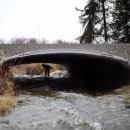States
WashingtonThe project to remove a pair of culverts and replace them with a bridge at the mouth of Smith Creek, near its junction with the Naselle River in Willapa Bay, Washington, has been successfully completed. The previous culverts obstructed access to 8.7 miles of freshwater stream spawning habitat, but their removal has restored a diverse habitat that supports salmon and Pacific lamprey.
In addition to benefiting these species, the barrier removal will also support coastal cutthroat trout, federally threatened green sturgeon, and various bird species, such as bald eagles and peregrine falcons, that rely on healthy fish populations for food. Willapa Bay is a vital ecosystem that sustains a wide variety of fish and wildlife. The newly constructed bridge is designed to withstand predicted sea level rise, ensuring the protection of community infrastructure for the future.
Project Quick Facts:
| Project Status | Complete |
| Location | WA, Pacific County |
| NFPP Project Funding | $1,050,000 |
| Restoration Techniques | Culvert Replacement |
| Accomplishments | 8.7 Stream Miles Reconnected, 140 Acres Reopened |
| Partner Project Lead | Pacific Conservation District |
The National Fish Passage Program combines technical expertise with a track record of success.
Implemented primarily through the Service's Fish and Wildlife Conservation Offices, the National Fish Passage Program provides financial and technical assistance to partners across the country. Since 1999, the program has worked with over 2,000 local communities, Tribes, and private landowners to remove or bypass over 3,400 barriers to fish passage fish passage
Fish passage is the ability of fish or other aquatic species to move freely throughout their life to find food, reproduce, and complete their natural migration cycles. Millions of barriers to fish passage across the country are fragmenting habitat and leading to species declines. The U.S. Fish and Wildlife Service's National Fish Passage Program is working to reconnect watersheds to benefit both wildlife and people.
Learn more about fish passage and reopen access to over 61,000 miles of upstream habitat for fish and other animals. Staff have expertise in fish migration and biology as well as financial, engineering, and planning assistance to communities, Tribes, and landowners to help them remove barriers and restore rivers for the benefit both fish and people.
Fish passage project proposals can be initiated by any individual, organization, government, or agency. However, proposals must be submitted and completed in cooperation with a Fish and Wildlife Conservation Office. (Please note that fish passage projects being used for federal or state compensatory mitigation or required by existing federal or state regulatory programs are not eligible for funding through the National Fish Passage Program.)
CONTACT A FISH PASSAGE COORDINATOR IN YOUR AREA TO GET STARTED.

